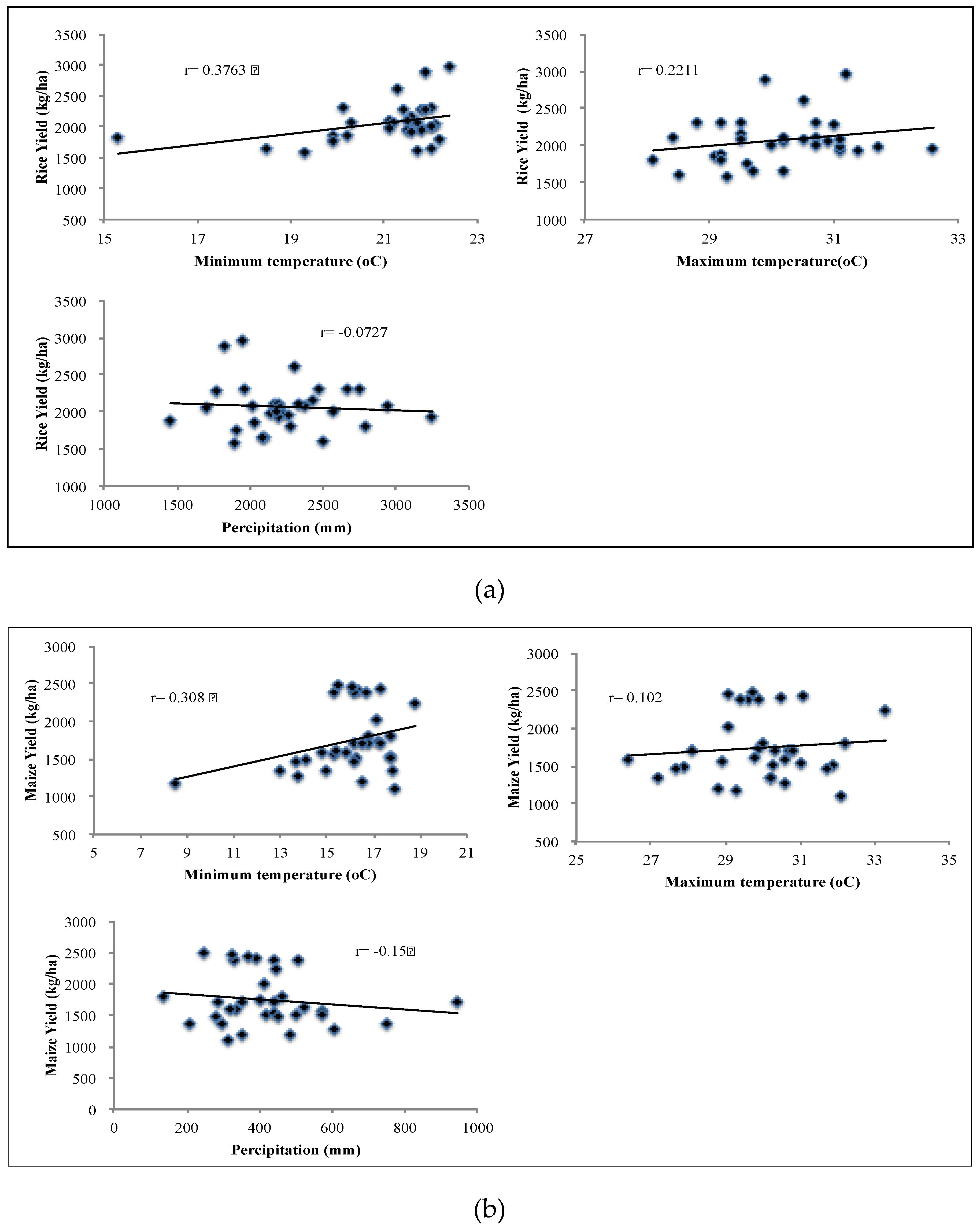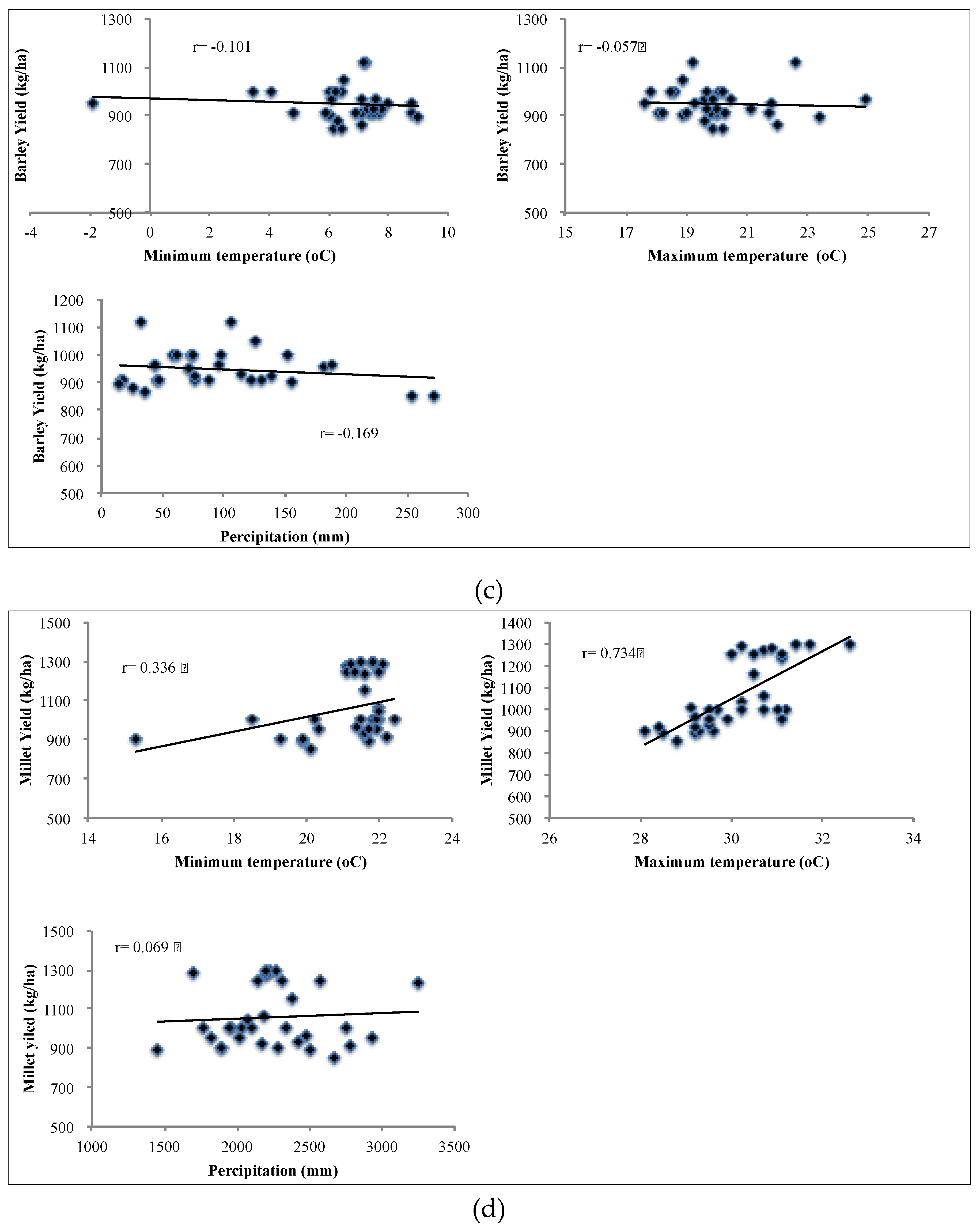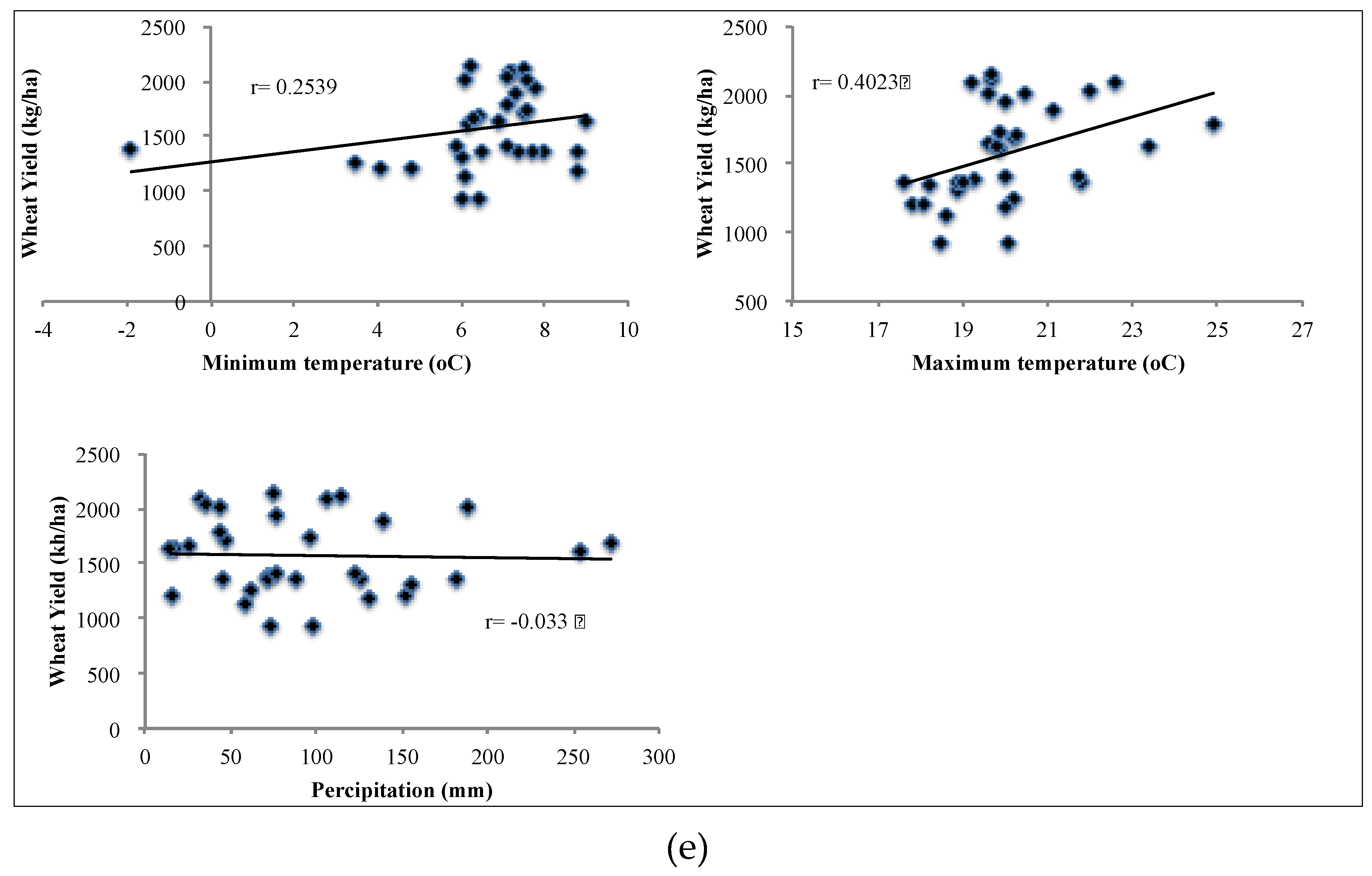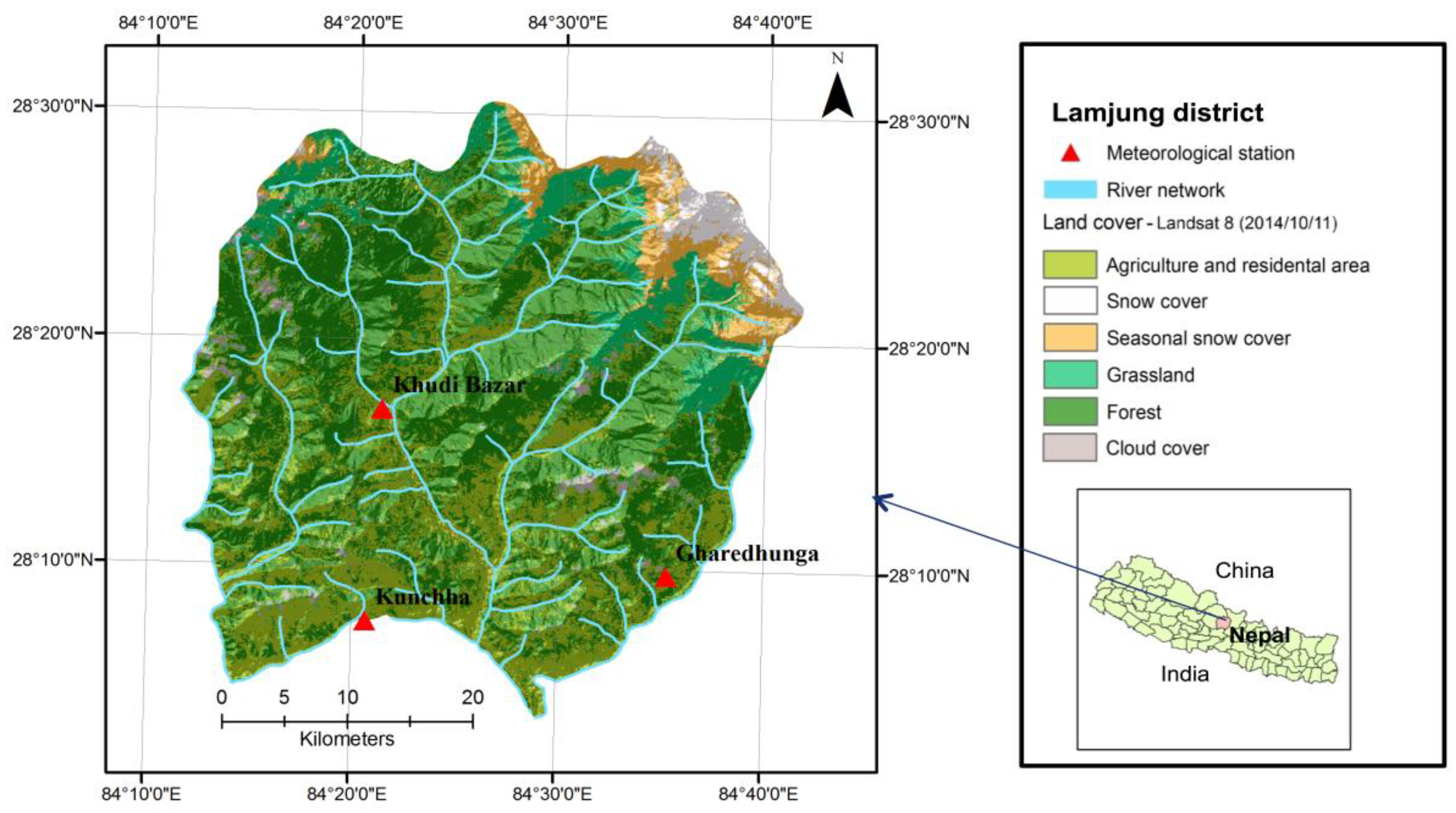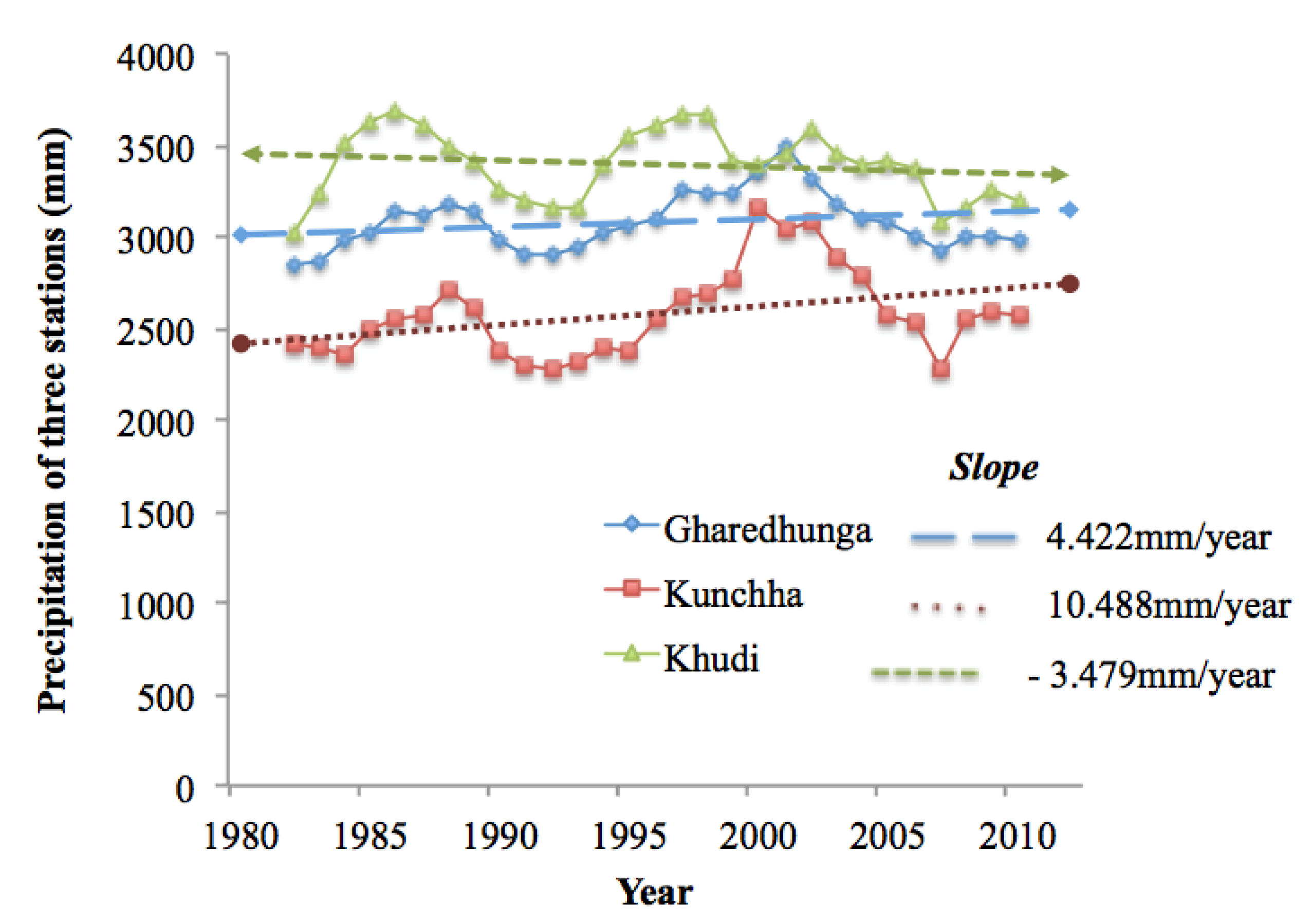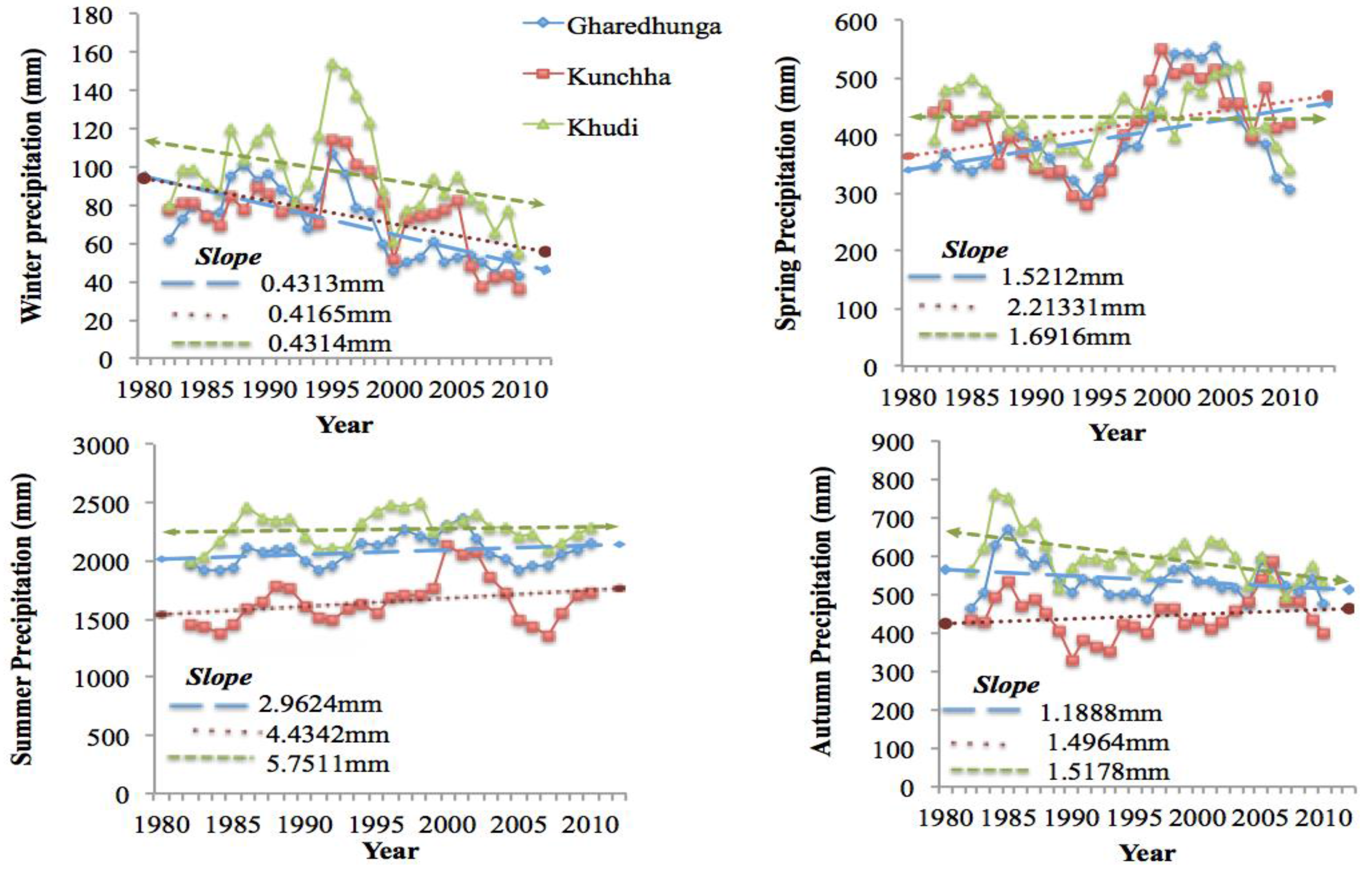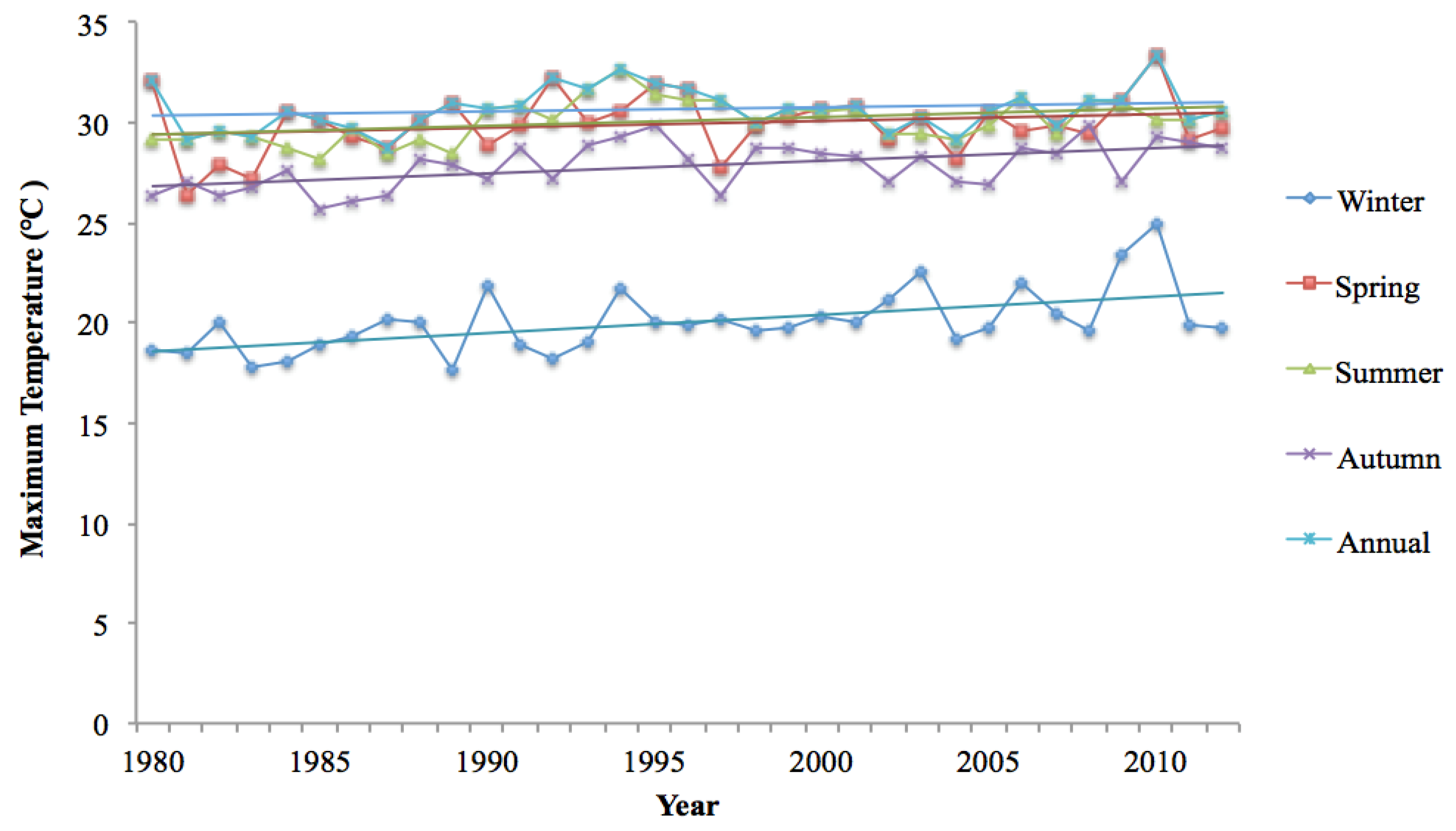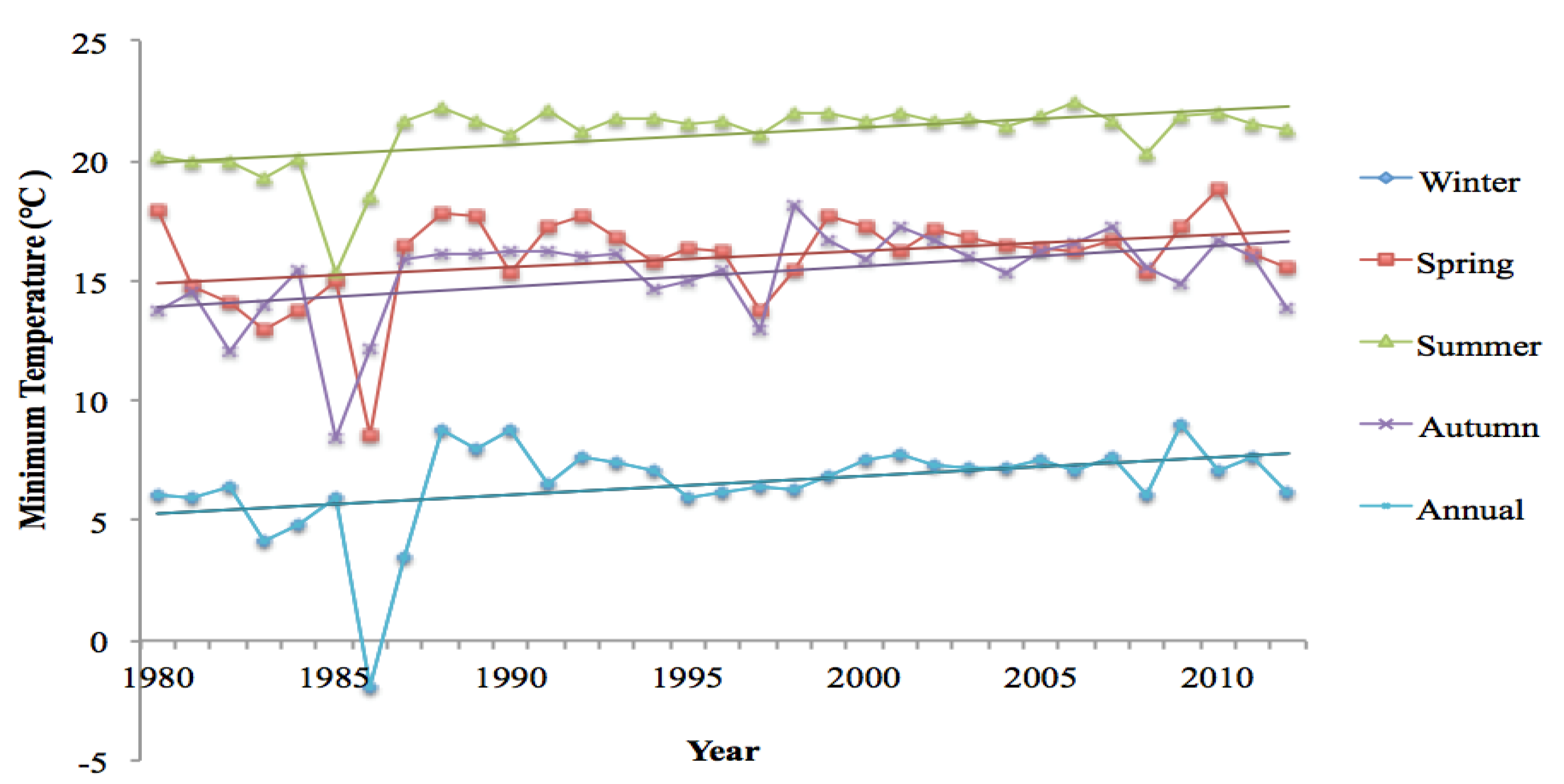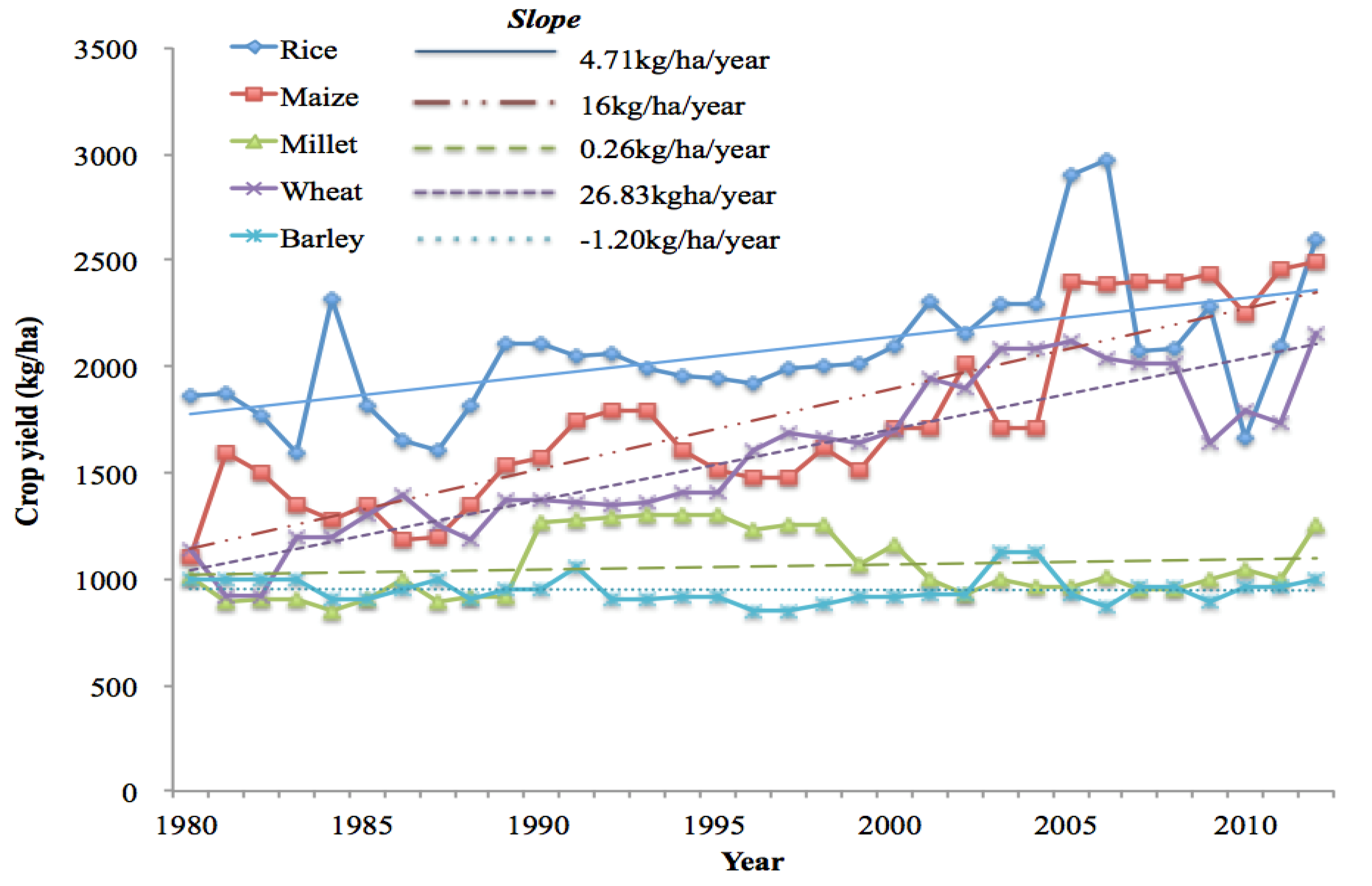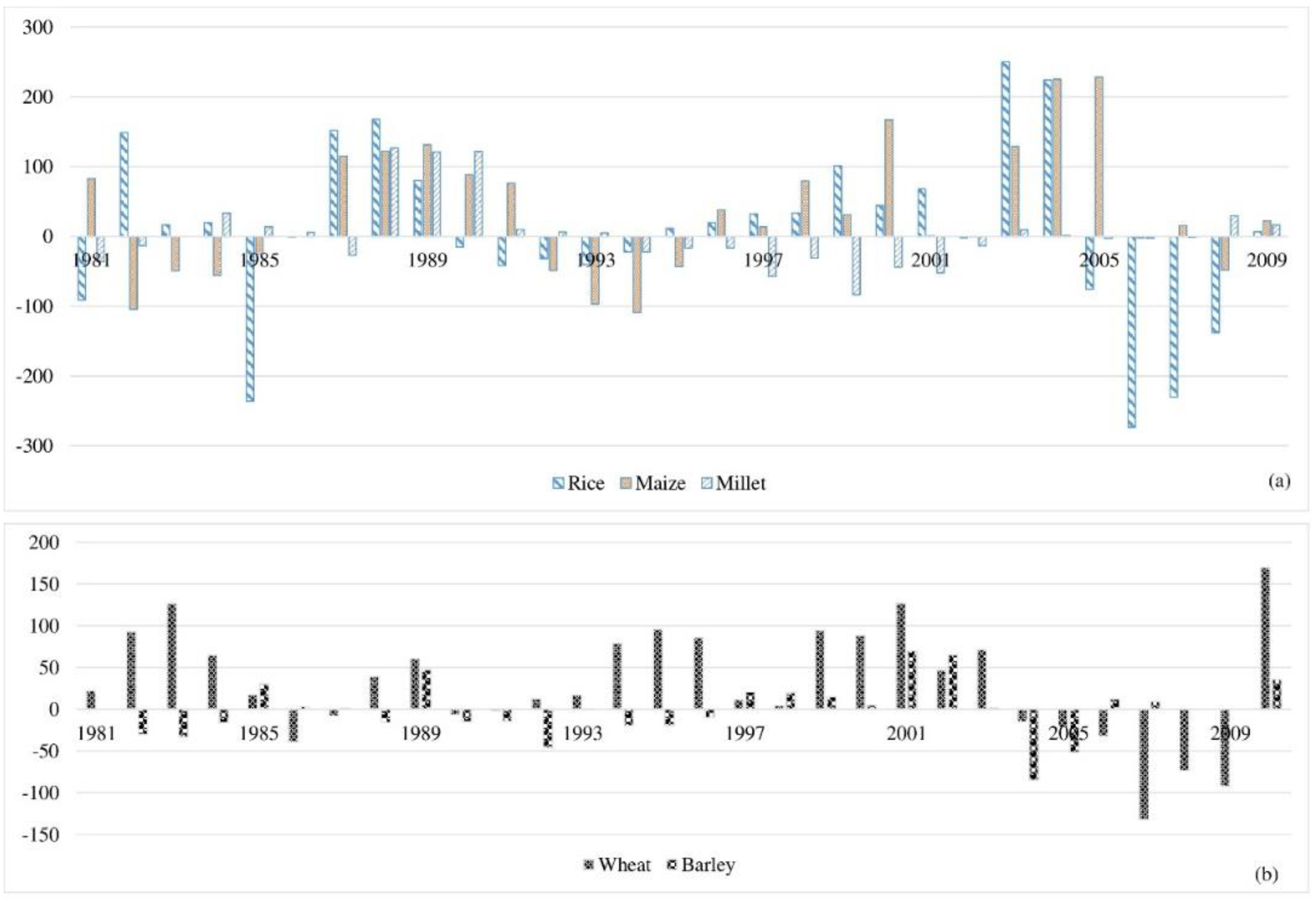1. Introduction
In the mountainous country of Nepal, more than 60% of the population is dependent on agriculture, which contributes 35% of the gross domestic product [
1]. Based on this statistic, it is clear that growth and development in the agricultural sector has a direct contribution on the national economy and livelihood of the people. Several crops can be cultivated in Nepal; however, five major crops,
i.e., rice, maize, wheat, millet and barley, dominate the agricultural sector [
2]. These crops represent more than 90% of the total grain production and cultivated area in Nepal [
2]. Rice and millet are the major summer crops, maize is a spring/summer crop, and wheat and barley are the winter crops (
Appendix 1). Among them, rice and maize are the primary crops that contribute more than half of the total food grain production of Nepal and are grown from the lowlands in the Terai (70 meters above sea level) through high hills (2830 meters above sea level) [
3]. Thus, the study of the various impacts of climate changes on these crop yields is urgently required for planning the future food availability in the country.
According to 5th assessment report of the Intergovernmental Panel on Climate Change [
4], compared to the 20th century, the average annual temperature will rise by more than 2 °C in most of the South Asia by the mid of 21st century, and by the late of 21st century, the temperature increases will exceed 3 °C and as much as 6 °C in high altitudes under a high-emission scenario. Similarly, under a low-emission scenario, the average temperature will rise by less than 2 °C in the 21st century, but at higher altitudes, the temperatures will rise by as much as 3 °C. It is anticipated that the increasing rate of the average temperature in the Himalaya will be greater than the global average. The increasing temperatures may affect the timing and quantity of precipitation, which would consequently change the water availability [
5].
Several studies have shown that the rate of temperature increase is higher at higher altitudes [
6,
7,
8]. Changing temperatures and erratic rainfall pattern are affecting crop production in Nepal [
9]. Similarly, the loss of local crops and domestic animals, changes in cropping patterns, scarcity of water due to the drying up of water resources, and increasing incidences of diseases and pests have also been observed [
10,
11]. Due to its heterogeneous topography, there is a high risk of natural disasters, such as glacier lake outburst floods (GLOFs), avalanches, landslides,
etc., in the higher altitudes and floods in the lower region. Hence, mountainous countries such as Nepal are more vulnerable to climate change [
12].
There is ample evidence to link the increase in extreme weather events, such as droughts and floods, with agricultural production. Due to the winter drought in 2008/2009, there was a huge loss in agricultural production in Nepal [
13,
14]. Because of the erratic monsoon weather conditions in India during 2009, the production of the main crops decreased, resulting in food crises in neighboring countries [
15]. Wassmann [
16] also argued that small household farmers, especially in marginalized regions of Asia, experience most of the negative effects of climate change because agriculture is adversely impacted in this region [
17].
In Nepal, a majority of the area is covered by hills, high mountains and lowland areas; therefore, there is a huge variation in weather. Similar changes can have different consequences at different altitudes. As the temperature increases, the higher mountainous areas may benefit, whereas lowland areas may suffer badly. Some studies have shown that the impact of global warming in the mountainous area could have a positive impact for some vegetables and crops, such as tomato, cauliflower, wheat, maize, and rice [
5,
18]. However, the decreasing winter precipitation may have an adverse impact on winter crops, which need more water or irrigation facilities.
Shrestha [
19] said that the growth and development of plants, outbreaks of pests and diseases, and water availability could be affected by changes in the temperature and precipitation patterns, thereby eventually affecting crop yields. Climate change will have a significant impact on agriculture, primarily through its effect on crop yields [
20,
21]. Most of these studies seeking to understand the physical effects of climatic variables on crop yield were conducted through crop simulation models. However, small changes in the climatic variables, specifically in temperature, are often excluded [
22]. Therefore, regression models based on historical yield data and climate data are relatively accurate for the prediction of changes in the yield due to climate change [
23,
24,
25].
Based on the climate change vulnerability, overall risk exposure and sensitivity data provided by the Nepal Government, Lamjung district, one of the 75 districts of Nepal, was selected. Lamjung is ranked as high risk in terms of climate change impacts [
26]. According to the report, the risk of flash floods, landslides, and GLOFs in Lamjung is also very high. Therefore, climate changes will also likely have a significant impact on the crop yield in this district; thus, a detailed study is required for this region. Hence, this study focuses on understanding how the climate is changing and discusses its impact on crop yields in a mountainous region of Nepal. The objectives of this study, therefore, include time series analysis of precipitation, temperature and yield of selected crops. Similarly, to explore the impact of climate change on crop yield, the relationship between yield and climatic variables are also analyzed through a regression model of climate and crop yield anomalies.
2. Study Area
Lamjung district is located in the western mountainous region of Nepal (
Figure 1). It is situated between 27°55’N and 28°25’N latitude and 85°00’E and 85°50’E longitude, and its elevation varies from 596 meters to 7893 meters above sea level. It has an area of 1692 km
2 and a population of 167,724.
Due to the heterogeneous topography and elevation variations, the temperature and precipitation varies seasonally and spatially. The summer (June–August) maximum temperature in the lower part of the district can reach 40 °C or higher, whereas the minimum temperature during winter is below freezing in most of the area. The distribution of precipitation also depends on the spatial location and time of the year. The monsoon contributes approximately 80% of the annual precipitation during the summer season, and westerly winds deliver winter (December–February) precipitation. Precipitation is in the form of rain in the lower-elevation regions and falls as snow in the higher-elevation regions, though there is no clear separation line due to the seasonal variations in temperature. During the other two seasons, autumn (September–November) and spring (March–May), the region receives occasional precipitation. These precipitation events are often in the form of hailstorms or snowstorms. It is reported that there is less snowfall during winter, and heavy and unpredictable snow or hail in early spring [
5]. Most importantly, Lamjung district is one of the most vulnerable districts (due to climate change) among the 75 districts in Nepal [
26]. Over the last two decades, long-term dry spells and unpredictable rainfall were observed several times in Lamjung district [
27].
Broadly, five types of land cover patterns are found in Lamjung. The land cover map developed from Landsat images taken in 2014 is presented in
Figure 1.
5. Discussion
The increasing trend of global warming is more evident in the mountainous areas than in the plains. Climate change is also likely to change the monsoon precipitation patterns in ways that could affect the current agricultural production of Nepal. After analyzing the data from the Lamjung district and conducting KIIs, this study found that there is a changing trend in the climatic variables. Additionally, the intensity and frequency of snowfall and rainfall have decreased in the higher altitudes over the last 20 years. The duration of summer has increased during this period, and the number of cold days has decreased. Similarly, the occurrence of existing pests and the emergence of new pests and diseases have been observed over the same period. These experiences agree with the results obtained from several studies in the region, as discussed in earlier sections.
The seasonal precipitation at various stations exhibited variation in trends. The precipitation in Lamjung is concentrated in the summer, with almost 80% of the annual precipitation falling then. The decreasing trend in winter precipitation and the increasing trend in summer precipitation indicate that precipitation in summer is becoming more intense. This could have a negative impact on crops due to water-induced disasters, such as floods and landslides, which eventually affect the crop yields. The total annual precipitation has increased at the Kunchha and Gharedhunga stations, but decreased at the Khudi station. In summary, the annual summer precipitation increased and the winter precipitation decreased in Lamjung. Joshi [
35] also revealed the same trends across Nepal, where summer precipitation increased and winter precipitation decreased from 1978 to 2008. The temperature data recorded at the Khudi station revealed that the maximum annual temperature and minimum annual temperature increased by 0.02 °C·year
−1 and 0.07 °C·year
−1, respectively, between 1980 and 2012.
The five crops studied here are grown in two seasons, with no autumn or spring crops in Lamjung. The yields of rice, maize and wheat increased by 4.71 kg/ha/year, 16 kg/ha/year and 26.83 kg/ha/year, respectively, but the increases fluctuated over the years. Similarly, the yield of millet increased steadily, whereas the yield of barley decreased. These two crops are the major food crops in the mountainous region of Nepal. The growth yield of barley was suppressed by the increased minimum and maximum temperatures and decreased precipitation. However, the increased summer temperature contributed positively to maize yield.
6. Conclusions
This study concludes that climate variables have differential impacts on the yield growth of different crops. However, winter crops are adversely affected by the current climate trends. The yield of barley, one of the staple foods in the mountainous region of Nepal, is decreasing due to increased temperatures and decreased precipitation. On the other hand, though temperature is increasing in summer, the increases in precipitation have contributed positively to the yield growth of summer crops. Thus, it is recommended that any programs that are working to minimize the adverse impact of climate change on food crops production should first consider the crop, such as barley and millet, that is being most affected by the higher temperatures relative to the other food crops. Moreover, these two crops are important staple foods in Nepal, especially in the mountainous and hill regions that are also exposed to higher degrees of vulnerability to climate change.
The results of this research can be used by organizations and researchers to assess the current climate variability and fluctuations and their impact on food crops. The main shortcoming of this study is the examination of the entire district as one unit, despite the huge diversity existing within it. Therefore, further investigation with better spatial and temporal resolution is highly recommended to better understand the patterns and consequences of extreme weather affecting agriculture in mountainous regions.
 Plantation/Transplantation
Plantation/Transplantation  Crop growing phase
Crop growing phase  Harvesting
Harvesting